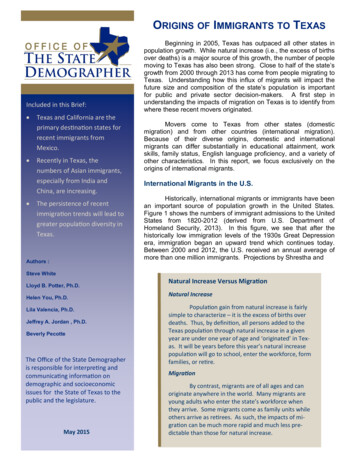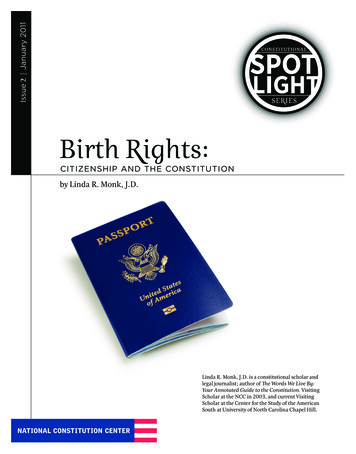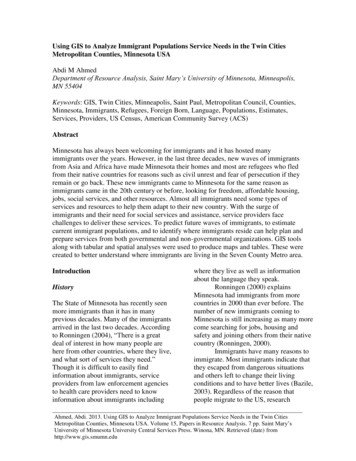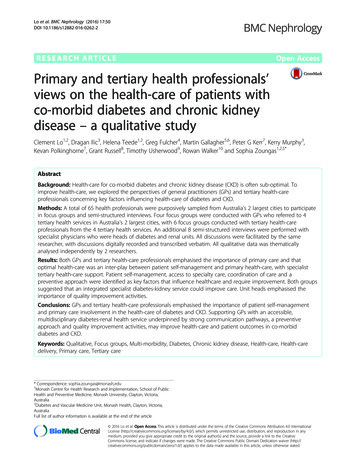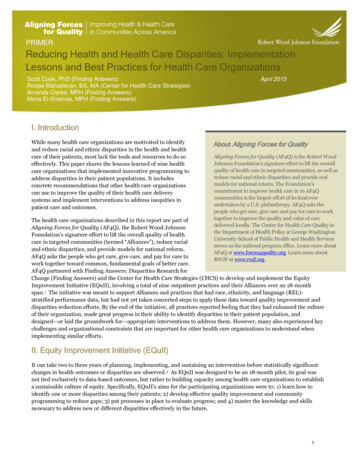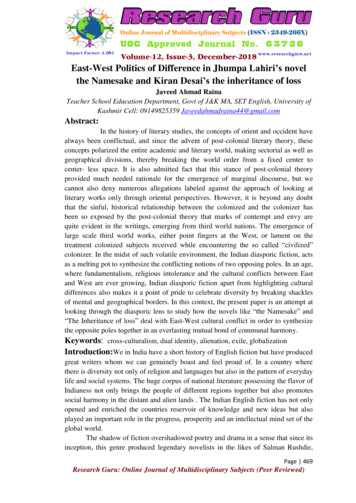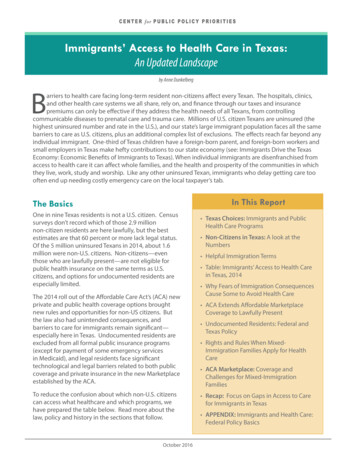
Transcription
Immigrants’ Access to Health Care in Texas:An Updated Landscapeby Anne DunkelbergBarriers to health care facing long-term resident non-citizens affect every Texan. The hospitals, clinics,and other health care systems we all share, rely on, and finance through our taxes and insurancepremiums can only be effective if they address the health needs of all Texans, from controllingcommunicable diseases to prenatal care and trauma care. Millions of U.S. citizen Texans are uninsured (thehighest uninsured number and rate in the U.S.), and our state’s large immigrant population faces all the samebarriers to care as U.S. citizens, plus an additional complex list of exclusions. The effects reach far beyond anyindividual immigrant. One-third of Texas children have a foreign-born parent, and foreign-born workers andsmall employers in Texas make hefty contributions to our state economy (see: Immigrants Drive the TexasEconomy: Economic Benefits of Immigrants to Texas). When individual immigrants are disenfranchised fromaccess to health care it can affect whole families, and the health and prosperity of the communities in whichthey live, work, study and worship. Like any other uninsured Texan, immigrants who delay getting care toooften end up needing costly emergency care on the local taxpayer’s tab.In This ReportThe BasicsOne in nine Texas residents is not a U.S. citizen. Censussurveys don’t record which of those 2.9 millionnon-citizen residents are here lawfully, but the bestestimates are that 60 percent or more lack legal status.Of the 5 million uninsured Texans in 2014, about 1.6million were non-U.S. citizens. Non-citizens—eventhose who are lawfully present—are not eligible forpublic health insurance on the same terms as U.S.citizens, and options for undocumented residents areespecially limited.The 2014 roll out of the Affordable Care Act’s (ACA) newprivate and public health coverage options broughtnew rules and opportunities for non-US citizens. Butthe law also had unintended consequences, andbarriers to care for immigrants remain significant—especially here in Texas. Undocumented residents areexcluded from all formal public insurance programs(except for payment of some emergency servicesin Medicaid), and legal residents face significanttechnological and legal barriers related to both publiccoverage and private insurance in the new Marketplaceestablished by the ACA.To reduce the confusion about which non-U.S. citizenscan access what healthcare and which programs, wehave prepared the table below. Read more about thelaw, policy and history in the sections that follow.October 2016 Texas Choices: Immigrants and PublicHealth Care Programs Non-Citizens in Texas: A look at theNumbers Helpful Immigration Terms Table: Immigrants’ Access to Health Carein Texas, 2014 Why Fears of Immigration ConsequencesCause Some to Avoid Health Care ACA Extends Affordable MarketplaceCoverage to Lawfully Present Undocumented Residents: Federal andTexas Policy Rights and Rules When MixedImmigration Families Apply for HealthCare ACA Marketplace: Coverage andChallenges for Mixed-ImmigrationFamilies Recap: Focus on Gaps in Access to Carefor Immigrants in Texas APPENDIX: Immigrants and Health Care:Federal Policy Basics
Table 1: Immigrants’ Access to Health Care in Texas, 2016Health Care Program or ServiceLawfully PresentImmigrantsUndocumentedImmigrantsNO for most immigrants who cameto U.S. on or after 8/22/1996Medicaid-Adults 19 and olderYES, for immigrants before8/22/1996, but limited to samecategories as U.S. citizens (very fewNOparents qualify, and no adults withoutdependent children unless pregnant,senior, or disabled)Medicaid-Children under age 19“Emergency Medicaid”- pays care providersfor emergency care only (not full coverage)YESNOYES, but only ER bills for individuals who, except for immigration status,meet all the same strict TX Medicaid limits that apply to U.S. citizenadults (very few parents qualify, and no adults without dependent childrenunless pregnant, senior, or disabled)CHIP-Children under age 19YESNOCHIP Perinatal Program-prenatal, delivery,and postpartum careYESYESYESMust have a U.S. CISverified refugee statusNOYESYESYESYESCounty Hospital or Health Districts andIndigent Care ProgramsYESVARIES by CountyMarketplace Insurance Coverage, withsubsidiesYESNOMarketplace Insurance Coverage, no subsidyYESNOInsurance purchase outside Marketplace,no subsidyYESYESRefugee Medical AssistanceMedical assistance to refugees for up to 8 months fromthe individual’s legal date of entry (those who applyafter their legal date of entry month receive less than 8months of RMA coverage).Programs using federal health care blockgrant funds (includes those run by state, county orcity): Examples: mental health, maternal and child health,family planning, communicable diseases, immunizationPrograms providing health servicesnecessary to protect life or safety, includesthose using federal, state or local funds. Emergencymedical, food, or shelter, mental health crisis, domesticviolence, crime victim assistance, disaster relief
Executive SummaryKey Findings and Recommendations for TexasWith over 4.6 million uninsured Texans in2015, substantial gaps in access to healthcare will remain a problem for many Texansin the near term, despite the important gains andnew options provided by the ACA. Listed below is apartial inventory of notable holes in the Texas healthcare safety net for non-U.S. citizen residents.Undocumented. The greatest access gaps for noncitizens affect Texans without legal immigrationstatus. Barred from Medicaid, CHIP, and theMarketplace and its subsidies, private healthcoverage is available only to undocumentedindividuals who have adequate income topurchase a policy at full price, without a subsidy.Undocumented residents can look to FederallyQualified Health Centers, some (but not all) urbanhospital/health districts, and independent charityclinics for care, meaning that access to affordablecare is highly variable depending on where animmigrant lives in Texas.Lawfully present: Immigrants who are lawfullypresent in the U.S. face certain barriers that arespecific to their non-citizen status, as well as some ofthe same barriers affecting U.S. citizens. The Coverage Gap traps some lawfully present,including refugees and asylum seekers. Mostlawfully present individuals with incomes below100 percent of the FPL can qualify for subsidies inthe ACA Marketplace. However, certain lawfullypresent immigrants are caught in the CoverageGap in states like Texas that have not acceptedfederal ACA funds to extend Medicaid to adultswho earn less than 138 percent of the FPL. Sothe categories of legal immigrants that Congressintended in 1996 to have access to Medicaidand CHIP, actually are the very ones who are leftwithout coverage options in Texas and otherstates that have not expanded Medicaid. Texas law excludes most lawfully presentimmigrant adults from Medicaid. The statelegislature would have to authorize a change tothis state policy (adopted in 1999) in order for aTexas solution to insure low-income Texans inthe Coverage Gap to also benefit lawfully presentadults below the poverty line. Technical Marketplace application processingissues for individuals with immigrationdocuments, as well as for mixed-status familieshave delayed coverage and discouraged eligibleTexans from completing enrollment. ImprovedMarketplace performance during the secondand third open enrollment period appearsto be improving enrollment rates but furtherimprovement is still needed. The “family glitch” affects both lawfully presentimmigrants and U.S. citizens. These familiesmay not qualify for premium subsidies in theMarketplace , and face either paying full price andan unlimited, unaffordable percentage of theirincomes for job-based or Marketplace insurancepremiums, or remaining uninsured. Affordability issues occur even for families thathave access to premium subsidies and out-ofpocket help in the Marketplace. Those belowpoverty may have a hard time affording 2percent of income in premiums with additionalcopayments and deductibles. Families at anyincome level who experience high health careneeds may face spending up to 20 percent ofincome before deductibles and out-of-pocketcaps kick in. Separated, but not divorced, parents may nothave access to Marketplace subsidies becauseof tax filing status or lack of access to incomeinformation on the absent spouse. Hard-to-verify incomes. The income verificationsystems that the Marketplace and state MedicaidCHIP programs rely on can work well for thosewith steady employment and predictable hoursand wages. They are less helpful for those workingirregular hours, multiple jobs, or being paid cashor by hand-written check. Advocates will need tomonitor the systems to identify and try to reduceany barriers to enrollment, renewal, or qualifyingfor premium subsidies that may result fromthe additional documentation families in thesesituations may have to produce on an ongoingbasis.
Recommendations to Improve Health CareAccess and OutcomesFederal law, Texas law and the state constitution combineto make Texas cities, counties, and hospitals the providersand funders of last resort for all of the uninsured. U.S.and Texas law allow federal and state government toreject the health costs of uninsured immigrants—lawfullypresent and undocumented alike—and shift them tolocal governments and health care providers. In this way,Texas’ policy decisions to turn down available federalsupport for the uninsured take a toll on local taxpayers,and on all the other services communities need to fund.CPPP recommends that Texas make the following threekey policy changes to increase federal funding forcoverage and care of immigrants:1. Providing Medicaid Maternity benefits to lawfullypresent immigrant women. Texas should providecomprehensive pregnancy benefits on par with thoseof U.S. citizens. Today, even legal permanent residentsare treated the same as undocumented mothers.2. Closing the Texas Coverage Gap, and insuring allcitizens 19-64 up to 138 percent of the federalpoverty line ( 27,724 for a family of 3). This stepwould do even more than #1 for maternal health, byallowing women access to medical homes beforeconception for healthier pregnancies, continuing theircare after birth to screen for and treat chronic medicalconditions, and thereby improving health for anyfuture pregnancies. This improved care will be gainedequally if accomplished via an 1115 “red state waiver”conservative alternative.Closing the Gap will also eliminate today’s perversepolicy which denies access to coverage to immigrantsCongress intended to protect: e.g., active-dutymilitary and veterans, victims of human trafficking,and refugees. Step #2 will also dramatically improvepayments to hospitals and doctors for emergency careto uninsured undocumented residents.3. Providing Medicaid benefits to lawfully presentimmigrants aged 19 and older. Lawmakers shouldalso reverse the Texas law that now excludes theseadults, in order to maximize the reduction in uninsuredlawfully present Texans and the relief for localgovernments that closing the Coverage Gap wouldbring. Texas Medicaid today covers very few U.S. citizenparents and adults under current policy: e.g., 3 millionchildren are enrolled, but only 150,000 of their parents.Unless Texas begins providing coverage options forU.S. citizen parents and other adults living in poverty,reversing Texas’ ban on Medicaid for lawfully presentimmigrant adults will have limited effect.Of course, the steps described above do not fully addressthe barriers to care for undocumented residents and thecosts of their care born by local governments and careproviders. Texas should take the lead among the states,squarely face the realities and negative consequencesof these barriers for our communities, and develop aproactive strategy to improve systems and financing ofcare for the undocumented uninsured.Why This Report?How to use this report to protect access to care in your communityThis report provides an updated overview of federal and state laws and rules governing access to health care in Texasfor non-U.S. citizens, and points out how local practices vary around the state. With a new presidential administrationbeginning in January 2017, changes to weaken protections in federal laws and rules could be proposed in the near future.Attempts to make health care less accessible to non-U.S. citizens are on the rise. In the past, health care stakeholders inTexas avoided direct talk about the programs and services available to non-citizens—even those lawfully present—inhopes that silence would reduce attacks on immigrants’ health care access. At CPPP, we believe that given the increasedfrequency of attacks on access, silence is no longer serving that end. Health care providers, community advocates,congregations, and concerned citizens all need to be armed with the facts about federal, state, and local laws and therights of immigrants. Only armed with this information can we ensure that laws are followed and rights are protected.CPPP is available to help educate organizations and community members, and to hear reports from those who observeviolations of law or policy, or need help understanding if a violation has occurred. Information on how to contact us is at theend of this report.CENTER FOR PUBLIC POLICY PRIORITIES CPPP.org 512-320-0222BetterTexasBlog.orgBetterTexasCPPP TX
Immigrants’ Access to Health Care in Texas: An Updated LandscapeTexas’ Choices: Legal Immigrants and Public Health Care ProgramsSee Appendix and Resources for more detailed federal policy background.1997: Texas Denies Medicaid to Most Recent Legal Immigrants.The Texas Legislature opted in 1997 to continue providing Medicaid to “qualified immigrants” (see HelpfulImmigration Terms box, p. 3, and Appendix) who came to the U.S. before the 1996 federal welfare law known asthe Personal Responsibility and Work Opportunity Reform Act (PRWORA, 8/22/1996). But the state Legislaturedecided to exclude qualified immigrants who came to the U.S. after that date, even when they have been in theU.S. for five years and qualify for federal Medicaid funding. (In 2001, the Legislature passed an omnibusMedicaid bill that would have reversed that decision and allowed post-1996 qualified immigrants to qualify forTexas Medicaid, but that bill was vetoed by the Governor).Non-Citizens in Texas: A Look at the NumbersTHE BIG PICTURE: U.S. Census estimates non-U.S. citizens made up 2.9 million of the 26.9 million Texans in 2014(Census, American Community Survey). U.S. Census does not determine which non-citizens are lawfully present and which are not. 68% of foreign-born Texans (including naturalized U.S. citizens) are of Latin American origin, 18% Asian. (MigrationPolicy Institute (MPI), 2014.)UNDOCUMENTED: Pew Hispanic Center estimates Texas was home to 1.7 million undocumented immigrants in 2012;MPI estimates about 1.5 million for 2014. The U.S. unauthorized immigrant population peaked in 2007 at about 12.2 million. Since 2008 the national total has declined by about 1 million and more undocumented immigrants have left thestate than have moved here, due to the global recession, increased border security, and greater risk to migrantsfrom criminals. The drop was due mostly to reduced immigration from Mexico. Additional sources: Pew Hispanic Center, Statistical Portrait of the Foreign-Born Population in the United States,September 2015; 5 facts about illegal immigration in the U.S., November 2015.CHILDREN: Though only 4% of Texas children are themselves foreign-born, in 2014 2.4 million Texas children (one-third of Texaschildren) had a foreign-born parent (Annie E Casey Foundation Kids Count project estimates).o Half of these children are in families in which neither parent is a U.S. citizen (includes both lawfully presentand undocumented parents).o Of Texas children in these mixed-status families, 33% live below the poverty line ( 20,160 for a family of 3),compared with 25% of all children. The Migration Policy Institute estimates that 45% of all low-income Texas children (those with family income below200% FPL, which is the upper limit for the Children's Health Insurance Program (CHIP), 40,320 for a family of 3)have at least one foreign-born parent. The Texas Medicaid program reports it covered costs for 213,253 Texas births in 2013.o That year, Texas Medicaid paid for deliveries for about 159,000 U.S. citizen mothers.o About 26% of Texas Medicaid births in 2013 were to non-U.S citizen mothers (about 55,000, includes bothlawfully present and undocumented mothers), representing about 15% of all Texas births that year.5
1999: Texas includes Legal Immigrant Children in CHIPThe option for each state to create a Children’s Health Insurance Program (CHIP) was established by Congress in1997 when the Texas Legislature was not in session, and the Legislature enacted CHIP coverage in 1999 in its nextregular session. The federal law required Texas to include qualified immigrant children who have been in the U.S.for at least five years in our separate (non-Medicaid) CHIP program, but provided no federal funding for thosechildren during their first five years in this country. The Texas Legislature opted to use 100 percent state funds tocover qualified immigrant children in CHIP during their first five years in the U.S. when no federal match wasavailable, convinced that promoting early intervention and a regular source of medical and dental care forchildren would be cost-effective in the long run.Helpful Immigration Terms“Alien” is a term used in many laws to refer to noncitizens (both lawfully present and undocumented).“Undocumented” Immigrants include 2 major groups, people who: Entered Without Inspection, or “EWIs” Overstayed their immigrant or nonimmigrant visas; these make up 25-40 percent of all undocumented immigrantsOther terms you may see: “not lawfully present,” “illegal aliens” (the latter term is not preferred or used in this report)“Legal Immigrant” – not a real term in law, but still is commonly used. There are many different lawful immigrationstatuses: Some are permanent or long-term statuses; that is, the immigrant can reside in the U.S. indefinitely. IncludesLawful permanent residents (LPRs), refugees, and asylum seekers (“asylees”). Others are temporary, or transitional statuses, which may be indefinite in length (for example, the spouse, childor fiancée of a U.S. citizen waiting to get LPR status may have a “K” Visa), or they may be required to get approvalfor renewal of status at regular intervals (e.g., “Temporary Protected Status”). Most LPRs immigrated through a family-based immigrant visa petition. All lawfully present immigrants are not treated equally with regard to access to health care.NOTE: “qualified” and “lawfully present” immigrants have different specific meanings in law and policy. They areitalicized in this report when they refer to a specific legal or regulatory definition.“Qualified” Immigrants A specific group of immigration statuses that was designated in the 1996 federal welfare law for the purpose ofestablishing new restrictions on eligibility for public benefits. (See appendix for detail)“Lawfully Present” immigrants Federal categorization of immigrants who are potentially eligible for Medicaid and CHIP under the state option tocover children and pregnant women established in 2009 federal law (under the Children's Health InsuranceProgram Reauthorization Act, CHIPRA), and for Marketplace insurance under the Affordable Care Act. It includesalmost all legal statuses, including non-immigrants with valid visas. (See appendix for detail) The words “lawfully present” are sometimes also used to refer generically to non-U.S. citizens who are notunauthorized. In this report we italicize lawfully present when it is used to refer to the specific grouping of lawfulstatuses established in federal law and policy related to access to health care and insurance programs.“Immigrant” versus “Nonimmigrant” visas “Immigrant” statuses include people seeking long-term or permanent residence. Tourists, students, people conducting business, temporary employees, or those traveling to the U.S. to receivemedical care are the primary examples of “non-immigrant” status.6
By 1999, federal legislation had already been introduced in response to PRWORA to give states the option toeliminate the five-year bar from Medicaid and CHIP for immigrant children and pregnant women. The authors ofTexas’ CHIP law therefore included a “trigger” in Texas law directing the program to accept federal funding forimmigrant children in their first five years, should Congress ever adopt that bill and make that option available.Today: Where Medicaid and CHIP stand in Texas Qualified immigrants who entered the U.S. before August 22, 1996 may participate in Medicaid on thesame terms as U.S. citizens. Most qualified immigrants ages 19 and older who entered the U.S. on or after August 22, 1996 are not ableto access Texas Medicaid (see Appendix for exceptions).oTexas is one of just six states that exclude qualified immigrant adults from Medicaid if they came tothe U.S. after the 1996 federal welfare law took effect. (Alabama, Mississippi, North Dakota, Virginia,and Wyoming are the others).oThis Texas policy means Medicaid maternity coverage is not available to qualified immigrant women.Instead, these women are treated the same as undocumented immigrant women. They canparticipate in the “CHIP Perinatal” program, which provides prenatal visits and limited postpartumcare, and “Emergency Medicaid” (more below) will pay the bill for labor and delivery. They cannot getcoverage with more comprehensive pre-conception care or postpartum health care. Texas also has extremely limited Medicaid coverage for adult U.S. citizens, because the state has not yetaccepted the federal funds available under the ACA to cover most U.S. citizen adults with incomes below 138percent of the federal poverty income level ( 27,821 for a family of 3). But even with the current limits inplace for U.S. citizen adults, tens of thousands of pregnant women and thousands of parents could gaincomprehensive health benefits if Texas stopped excluding qualified immigrant adults who came here on orafter August 22, 1996 from Medicaid coverage. If the state moves forward to accept the coverage of all U.S. citizen adults up to 138 percent FPL, taking theadditional step of ending the exclusion of adult qualified immigrants from Texas Medicaid would be needed,to provide affordable coverage to legal immigrant adults in that income group. Lawfully present immigrants 18 and younger may participate in Texas Children’s Medicaid and CHIP on thesame terms as U.S. citizen children. When Texas CHIP was launched in 2000, all qualified immigrant childrenwith incomes below 200 percent of the federal poverty income were enrolled in CHIP (not Medicaid). WhenCongress passed the Children's Health Insurance Program Reauthorization Act in 2009 (CHIPRA), it created theoption for states to get federal matching funds for children and pregnant women without a 5-year wait. Asdirected by Texas’ 1999 CHIP law, Texas Medicaid and CHIP then implemented the option to accept thefederal funds for children in Medicaid and CHIP (but not for pregnant women), without a 5-year wait. Congressional CHIP Reauthorization in 2009 also extended the categories of eligible immigrant children to thebroader group of lawfully present children (see Appendix). Lawfully present immigrant children today arecovered in Texas Medicaid and CHIP according to the same income guidelines as U.S. citizen children.7
Importantly, under the CHIP Reauthorization, the U.S. “sponsors” of immigrant children and pregnant womencovered in Medicaid or CHIP are not liable for repayment of health care costs, and a sponsor’s income is notcounted as part of the immigrant’s income for eligibility purposes (see below, Sponsor Income and Liability,and Fears of Immigration Consequences). CHIP Perinatal Program. Texas authorized the CHIP Perinatal program in 2005 using CHIP funding to provideprenatal visits and limited postpartum care to both lawfully present and undocumented immigrant motherswith incomes below 200 percent of the federal poverty line ( 40,320 for a family of three), because they areexcluded from Medicaid Maternity coverage. Emergency Medicaid (more below) pays the bill for labor anddelivery. (CHIP perinatal also is available to U.S. citizen mothers with incomes between 185-200 percent of theFPL). State and Local Health Care Programs. Federal law and regulations provide access to all other health careprograms—such as maternity care, mental health, immunizations, disease control—for qualified immigrants(see Appendix). Importantly, state and local health programs cannot add their own immigrant restrictions toany public health programs that use those unrestricted federal funds. Texas operates relatively few publichealth programs that do not mix federal funds with state dollars.The most common locally funded and operated health care programs in Texas are hospital and health districtfunded medical assistance programs typically found in the largest urban counties, and the County IndigentHealth Care programs in most smaller-population counties without hospital or health districts. Texas HospitalDistricts do have an obligation under both state law and the Texas Constitution to serve all needy residents.As a general rule, local health care programs have not restricted access by qualified immigrants.Individuals with “non-immigrant” status (such as student, tourist, and employment visa holders) are requiredto prove that they are residents in some Texas localities in order to use these health care programs. What isaccepted to prove residency differs from place to place, but in some locales includes rent receipts or utilitybills, to establish some intent to reside in the community. Federal rules for Medicaid and the Health insuranceMarketplace prohibit state Medicaid programs or Marketplaces from defining a person to be a non-residentbased strictly on their immigration status or type of visa.i The federal rules represent a fairly new bestpractice, and may influence Texas counties to update their policies in places that reportedly still assign nonresident status to immigrants based solely on their visa type. Sponsors’ Income and Liability. Many Lawful Permanent Residents (often called “green card” holders) aresponsored by a relative or others who promise to help provide for the new immigrant’s needs. In 2011, thestate Legislature adopted a new law allowing county health care programs to count (“deem”) the income andresources of immigrants’ sponsors when determining if an immigrant is eligible for a Hospital District orCounty Indigent Health Care program. The same legislation also gave those programs the option to recovercosts of care from the sponsors, and directed the Texas Medicaid program to do the same if cost effective. Ofcourse, counting the income of a separate household as though it were available to the immigrant reducesthe ability of an immigrant family to qualify for care. It’s not known how common the practice is in Texas,since at this time it appears that no state entity maintains a centralized record of the policies adopted by localgovernments.8
ACA Extends Affordable Marketplace Coverage to those Lawfully PresentWhen the ACA was passed in 2010, it made the same group of “lawfully present” immigrants defined in the 2009CHIP Reauthorization eligible to participate in the new health insurance Marketplace in 2014. Those with incomesbelow four times the federal poverty line income ( 80,640 for a family of three in 2016) can qualify for reducedcost insurance through lower premiums (subsidized with “premium tax credits”) and reduced out-of-pocket costs(“cost-sharing reductions”) for families with incomes below 250 percent of the federal poverty line. Just like U.S.citizens, lawfully present immigrants who are offered “affordable” job-based coverage do not have access tomarketplace subsidies (more later, see “Family Glitch”).Why Fears of Immigration Consequences Cause Some to Avoid Health CareFear of being Labeled a “Public Charge”Some immigrants fear that using publicly sponsored health care or subsidies will prevent them from getting legalstatus or citizenship. Federal policy in place since 1999 has tried to reassure non-citizens that use of health care byeligible people will not create barriers to immigration or citizenship, but confusion and fear remain among bothundocumented and lawfully present immigrants.The only way health care use can prevent a green card holder from becoming a citizen is if he or she committedfraud to get those benefits (for example, misrepresented his or her income, state residence or immigration status).Sponsor “deeming” and liabilityMany Lawful Permanent Residents (sometimes called “green card” holders) are sponsored by a relative or others whopromise to provide for the new immigrant’s needs. In some situations, the sponsor’s income can be counted(“deemed”) as if available to the sponsored person in determining eligibility for health care services. And thoughasking sponsors to repay the costs of care (“liability”) provided to those they sponsor is almost unheard of, it istechnically possible under the law in some cases and thus creates a barrier for some immigrants. Care for children inTexas CHIP or Medicaid is exempt from sponsor deeming and liability.Reporting to the U.S. Citizenship & Immigration Services (USCIS, formerly INS)Medicaid, CHIP, other health programs and health care providers are not required to report all undocumentedpersons to immigration authorities. Indeed the Department of Homeland Security has confirmed that it will not useinformation provided by health care applicants for immigration
Table 1: Immigrants' Access to Health Care in Texas, 2016 Health Care Program or Service Lawfully Present Immigrants Undocumented Immigrants Medicaid-Adults 19 and older NO for most immigrants who came to U.S. on or after 8/22/1996 YES, for immigrants before 8/22/1996, but limited to same categories as U.S. citizens (very few
